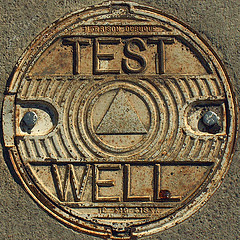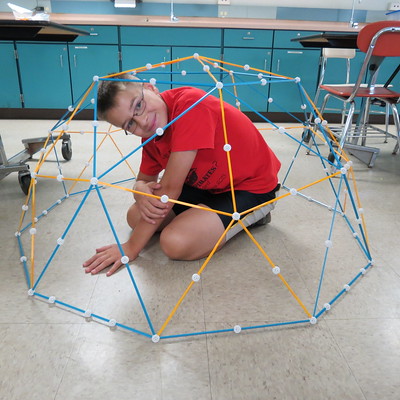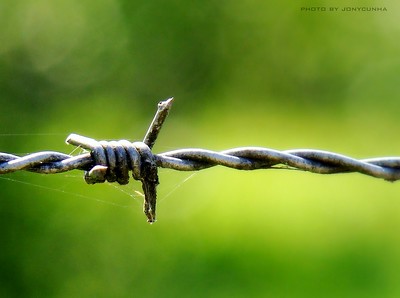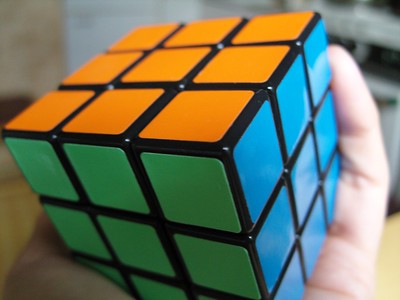Posts Tagged ‘Learning’
Testing is an important part of designing.
 When you design something, you create a solution to a collection of problems. But it goes far beyond creating the solution. You also must create objective evidence that demonstrates that the solution does, in fact, solve the problems. And the reason to generate this evidence is to help the organization believe that the solution solves the problem, which is an additional requirement that comes with designing something. Without this belief, the organization won’t go out to the customer base and convince them that the solution will solve their problems. If the sales team doesn’t believe, the customers won’t believe.
When you design something, you create a solution to a collection of problems. But it goes far beyond creating the solution. You also must create objective evidence that demonstrates that the solution does, in fact, solve the problems. And the reason to generate this evidence is to help the organization believe that the solution solves the problem, which is an additional requirement that comes with designing something. Without this belief, the organization won’t go out to the customer base and convince them that the solution will solve their problems. If the sales team doesn’t believe, the customers won’t believe.
In school, we are taught to create the solution, and that’s it. Here are the drawings, here are the materials to make it, here is the process documentation to build it, and my work here is done. But that’s not enough.
Before designing the solution, you’ve got to design the tests that create objective evidence that the solution actually works, that it provides the right goodness and it solves the right problems. This is an easy thing to say, but for a number of reasons, it’s difficult to do. To start, before you can design the right tests, you’ve got to decide on the right problems and the right goodness. And if there’s disagreement and the wrong tests are defined, the design community will work in the wrong areas to generate the wrong value. Yes, there will be objective evidence, and, yes, the evidence will create a belief within the organization that problems are solved and goodness is achieved. But when the sales team takes it to the customer, the value proposition won’t resonate and it won’t sell.
Some questions to ask about testing. When you create improvements to an existing product, what is the family of tests you use to characterize the incremental goodness? And a tougher question: When you develop a new offering that provides new lines of goodness and solves new problems, how do you define the right tests? And a tougher question: When there’s disagreement about which tests are the most important, how do you converge on the right tests?
Image credit — rjacklin1975
Three Things for the New Year
 Next year will be different, but we don’t know how it will be different. All we know is that it will be different.
Next year will be different, but we don’t know how it will be different. All we know is that it will be different.
Some things will be the same and some will be different. The trouble is that we won’t know which is which until we do. We can speculate on how it will be different, but the Universe doesn’t care about our speculation. Sure, it can be helpful to think about how things may go, but as long as we hold on to the may-ness of our speculations. And we don’t know when we’ll know. We’ll know when we know, but no sooner. Even when the Operating Plan declares the hardest of hard dates, the Universe sets the learning schedule on its own terms, and it doesn’t care about our arbitrary timelines.
What to do?
Step 1. Try three new things. Choose things that are interesting and try them. Try to try them in parallel as they may interact and inform each other. Before you start, define what success looks like and what you’ll do if they’re successful and if they’re not. Defining the follow-on actions will help you keep the scope small. For things that work out, you’ll struggle to allocate resources for the next stages, so start small. And if things don’t work out, you’ll want to say that the projects consumed little resources and learned a lot. Keep things small. And if that doesn’t work, keep them smaller.
Step 2. Rinse and repeat.
I wish you a happy and safe New Year. And thanks for reading.
Mike
“three” by Travelways.com is licensed under CC BY 2.0
Effective Interactions During Difficult Times
 When times are stressful, it’s more difficult to be effective and skillful in our interactions with others. Here are some thoughts that could help.
When times are stressful, it’s more difficult to be effective and skillful in our interactions with others. Here are some thoughts that could help.
Decide how you want to respond, and then respond accordingly.
Before you respond, take a breath. Your response will be better.
If you find yourself responding before giving yourself permission, stop your response and come clean.
Better responses from you make for even better responses from others.
If you interrupt someone in the middle of their sentence so you can make your point, you made a different point.
If you find yourself preparing your response while listening to someone, that’s not listening.
If you recognize you’re not listening, now there are at least two people who know the truth.
When there are no words coming from your mouth, that doesn’t constitute listening.
The strongest deterrent to listening is talking.
If you disagree with one element of a person’s position, you can, at the same time, agree with other elements of their position. That’s how agreement works.
If you start with agreement, even the smallest bit, disagreement softens.
Before you can disagree, it’s important to listen and understand. And it’s the same with agreement.
It’s easy to agree if that’s what you want to accomplish. And it’s the same for disagreement.
If you want to move toward agreement, start with understanding.
If you want to demonstrate understanding, start with listening.
If you want to demonstrate good listening, start with kindness.
Here are three mantras I find helpful:
Talk less to listen more.
Before you respond, take a breath.
Kindness before agreement.
“Rock-em” by REL Waldman is licensed under CC BY-SA 2.0
How To Be Novel
 By definition, the approach that made you successful will become less successful over time and, eventually, will run out of gas. This fundamental is not about you or your approach, rather it’s about the nature of competition and evolution. There’s an energy that causes everything to change, grow and improve and your success attracts that energy. The environment changes, the people change, the law changes and companies come into existence that solve problems in better and more efficient ways. Left unchanged, every successful business endeavor (even yours) has a half-life.
By definition, the approach that made you successful will become less successful over time and, eventually, will run out of gas. This fundamental is not about you or your approach, rather it’s about the nature of competition and evolution. There’s an energy that causes everything to change, grow and improve and your success attracts that energy. The environment changes, the people change, the law changes and companies come into existence that solve problems in better and more efficient ways. Left unchanged, every successful business endeavor (even yours) has a half-life.
If you want to extend the life of your business endeavor, you’ve got to be novel.
By definition, if you want to grow, you’ve got to raise your game. You’ve got to do something different. You can’t change everything, because that’s inefficient and takes too long. So, you’ve got to figure out what you can reuse and what you’ve got to reinvent.
If you want to grow, you’ve got to be novel.
Being novel is necessary, but expensive. And risky. And scary. And that’s why you want to add just a pinch of novelty and reuse the rest. And that’s why you want to try new things in the smallest way possible. And that’s why you want to try things in a time-limited way. And that’s why you want to define what success looks like before you test your novelty.
Some questions and answers about being novel:
Is it easy to be novel? No. It’s scary as hell and takes great emotional strength.
Can anyone be novel? Yes. But you need a good reason or you’ll do what you did last time.
How can I tell if I’m being novel? If you’re not scared, you’re not being novel. If you know how it will turn out, you’re not being novel. If everyone agrees with you, you’re not being novel.
How do I know if I’m being novel in the right way? You cannot. Because it’s novel, it hasn’t been done before, and because it hasn’t been done before there’s no way to predict how it will go.
So, you’re saying I can’t predict the outcome of being novel? Yes.
If I can’t predict the outcome of being novel, why should I even try it? Because if you don’t, your business will go away.
Okay. That last one got my attention. So, how do I go about being novel? It depends.
That’s not a satisfying answer. Can you do better than that? Well, we could meet and talk for an hour. We’d start with understanding your situation as it is, how this current situation came to be, and talk through the constraints you see. Then, we’d talk about why you think things must change. I’d then go away for a couple of days and think about things. We’d then get back together and I’d share my perspective on how I see your situation. Because I’m not a subject matter expert in your field, I would not give you answers, but, rather, I’d share my perspective that you could use to inform your choice on how to be novel.
“Giraffe trying to catch a twig with her tongue” by Tambako the Jaguar is licensed under CC BY-ND 2.0
How to Decide if Your Problem is Worth Solving
 How to decide if a problem is worth solving?
How to decide if a problem is worth solving?
If it’s a new problem, try to solve it.
If it’s a problem that’s already been solved, it can’t be a new problem. Let someone else re-solve it.
If a new problem is big, solve it in a small way. If that doesn’t work, try to solve it in a smaller way.
If there’s a consensus that the problem is worth solving, don’t bother. Nothing great comes from consensus.
If the Status Quo tells you not to solve it, you’ve hit paydirt!
If when you tell people about solving the problem they laugh, you’re onto something.
If solving the problem threatens the experts, double down.
If solving the problem obsoletes your most valuable product, solve it before your competition does.
If solving the problem blows up your value proposition, light the match.
If solving the problem replaces your product with a service, that’s a recipe for recurring revenue.
If solving the problem frees up a factory, well, now you have a free factory to make other things.
If solving the problem makes others look bad, that’s why they’re trying to block you from solving it.
If you want to know if you’re doing it right, make a list of the new problems you’ve tried to solve.
If your list is short, make it longer.
“CERDEC Math and Science Summer Camp, 2013” by CCDC_C5ISR is licensed under CC BY 2.0
If you “don’t know,” you’re doing it right.
 If you know how to do it, it’s because you’ve done it before. You may feel comfortable with your knowledge, but you shouldn’t. You should feel deeply uncomfortable with your comfort. You’re not trying hard enough, and your learning rate is zero.
If you know how to do it, it’s because you’ve done it before. You may feel comfortable with your knowledge, but you shouldn’t. You should feel deeply uncomfortable with your comfort. You’re not trying hard enough, and your learning rate is zero.
Seek out “don’t know.”
If you don’t know how to do it, acknowledge you don’t know, and then go figure it out. Be afraid, but go figure it out. You’ll make mistakes, but without mistakes, there can be no learning.
No mistakes, no learning. That’s a rule.
If you’re getting pressure to do what you did last time because you’re good at it, well, you’re your own worst enemy. There may be good profits from a repeat performance, but there is no personal growth.
Why not find someone with “don’t know” mind and teach them?
Find someone worthy of your time and attention and teach them how. The company gets the profits, an important person gets a new skill, and you get the satisfaction of helping someone grow.
No learning, no growth. That’s a rule.
No teaching, no learning. That’s a rule, too.
If you know what to do, it’s because you have a static mindset. The world has changed, but you haven’t. You’re walking an old cowpath. It’s time to try something new.
Seek out “don’t know” mind.
If you don’t know what to do, it’s because you recognize that the old way won’t cut it. You know have a forcing function to follow. Follow your fear.
No fear, no growth. That’s a rule.
Embrace the “don’t know” mind. It will help you find and follow your fear. And don’t shun your fear because it’s a leading indicator of novelty, learning, and growth.
“O OUTRO LADO DO MEDO É A LIBERDADE (The Other Side of the Fear is the Freedom)” by jonycunha is licensed under CC BY-SA 2.0
Some Problems With Problems
 If you don’t know what the problem is, that’s your first problem.
If you don’t know what the problem is, that’s your first problem.
A problem can’t be a problem unless there’s a solution. If there’s no possible solution, don’t try to solve it, because it’s not a problem.
If there’s no problem, you have a big problem.
If you’re trying to solve a problem, but the solution is outside your sphere of influence, you’re taking on someone else’s problem.
If someone tries to give you a gift but you don’t accept it, it’s still theirs. It’s like that with problems.
If you want someone to do the right thing, create a problem for them that, when solved, the right thing gets done.
Problems are good motivators and bad caretakers.
A problem is between two things, e.g., a hammer and your thumb. Your job is to figure out the right two things.
When someone tries to give you their problem, keep your hands in your pockets.
A problem can be solved before it happens, while it happens, or after it happened. Each time domain has different solutions, different costs, and different consequences. Your job is to choose the most appropriate time domain.
If you have three problems, solve one at a time until you’re done.
Solving someone else’s problem is a worst practice.
If you solve the wrong problem, you consume all the resources needed to solve the right problem without any of the benefits of solving it.
Ready, fire, aim is no way to solve problems.
When it comes to problems, defining IS solving.
If you learn one element of problem-solving, learn to see when someone is trying to give you their problem.
“My first solved Rubik’s cube” by Nina Stawski is licensed under CC BY 2.0
What Good Coaches Do
 Good coaches listen to you. They don’t judge, they just listen.
Good coaches listen to you. They don’t judge, they just listen.
Good coaches continually study the game. They do it in private, but they study.
Good coaches tell you that you can do better, and that, too, they do in private.
Good coaches pick you up off the floor. They know that getting knocked over is part of the game.
Good coaches never scream at you, but they will cry with you.
Good coaches never stop being your coach. Never.
Good coaches learn from you, and the best ones tell you when that happens.
Good coaches don’t compromise. Ever.
Good coaches have played the game and have made mistakes. That’s why they’re good coaches.
Good coaches do what’s in your best interest, not theirs.
Good coaches are sometimes wrong, and the best ones tell you when that happens.
Good coaches don’t care what other people think of them, but they care deeply about you.
Good coaches are prepared to be misunderstood, though it’s not their preference.
Good coaches let you bump your head or smash your knee, but, otherwise, they keep you safe.
Good coaches earn your trust.
Good coaches always believe you and perfectly comfortable disagreeing with you at the same time.
Good coaches know it’s always your choice, and they know that’s how deep learning happens.
Good coaches stick with you, unless you don’t do your part.
Good coaches don’t want credit. They want you to grow.
Good coaches don’t have a script. They create a custom training plan based on your needs.
Good coaches simplify things when it’s time, unless it’s time to make things complicated.
Good coaches aren’t always positive, but they are always truthful.
Good coaches are generous with their time.
Good coaches make a difference.
Certainty or novelty – it’s your choice.
 When you follow the best practice, by definition your work is not new. New work is never done the same way twice. That’s why it’s called new.
When you follow the best practice, by definition your work is not new. New work is never done the same way twice. That’s why it’s called new.
Best practices are for old work. Usually, it’s work that was successful last time. But just as you can never step into the same stream twice, when you repeat a successful recipe it’s not the same recipe. Almost everything is different from last time. The economy is different, the competitors are different, the customers are in a different phase of their lives, the political climate is different, interest rates are different, laws are different, tariffs are different, the technology is different, and the people doing the work are different. Just because work was successful last time doesn’t mean that the old work done in a new context will be successful next time. The most important property of old work is the certainty that it will run out of gas.
When someone asks you to follow the best practice, they prioritize certainty over novelty. And because the context is different, that certainty is misplaced.
We have a funny relationship with certainty. At every turn, we try to increase certainty by doing what we did last time. But the only thing certain with that strategy is that it will run out of gas. Yet, frantically waving the flag of certainty, we continue to double down on what we did last time. When we demand certainty, we demand old work. As a company, you can have too much “certainty.”
When you flog the teams because they have too much uncertainty, you flog out all the novelty.
What if you start the design review with the question “What’s novel about this project?” And when the team says there’s nothing novel, what if you say “Well, go back to the drawing board and come back with some novelty.”? If you seek out novelty instead of squelching it, you’ll get more novelty. That’s a rule, though not limited to novelty.
A bias toward best practices is a bias toward old work. And the belief underpinning those biases is the belief that the Universe is static. And the one thing the Universe doesn’t like to be called is static. The Universe prides itself on its dynamic character and unpredictable nature. And the Universe isn’t above using karma to punish those who call it names.
“Stonecold certainty” by philwirks is licensed under CC BY-ND 2.0
When You Have Disagreement
 When you have nothing to say, don’t say it.
When you have nothing to say, don’t say it.
But, when you have something to say, you must say it.
When you think your response might be taken the wrong way, it will.
When you take care to respond effectively, your response might be taken the wrong way.
When you have disagreement, there’s objective evidence that at least two people are thinking for themselves.
When you have disagreement, confrontation is optional.
When you have disagreement, everyone can be right, even if just a little.
When you have disagreement, that says nothing about the people doing the disagreeing.
When you have disagreement at high decibels, that’s an argument.
When you have disagreement, disagreeing on all points is a choice.
When you have disagreement, if you listen to sharpen your response, it’s a death spiral.
When you have disagreement, it’s best to disagree wholeheartedly and respectfully.
When you have disagreement, if you listen to understand, there’s hope.
When you have disagreement, it’s a disagreement about ideas and not moral character.
When you have disagreement, intentions matter.
When you have disagreement, decision quality skyrockets.
When you have disagreement, thank your partner in crime for sharing their truth.
When you have disagreement, there is sufficient trust to support the disagreement.
When you have disagreement, sometimes you don’t, but you don’t know it.
When you have disagreement, converging on a single point of view is not the objective.
When you have disagreement about ethics, you may be working at the wrong company.
When you have disagreement, there are no sides, only people doing their best.
When you have disagreement, the objective is understanding.
When you have disagreement, it’s the right thing to have.
When you have disagreement, there may be disagreement on the topic of the disagreement.
When you have disagreement, you are a contributing member, even if you stay quiet.
When you have disagreement, why not be agreeable?
When you have disagreement, it’s okay to change your mind.
When you have disagreement, you may learn something about yourself.
“Day 7: I disagree” by Stupid Dingo is licensed under CC BY 2.0
Musings on Skillfulness
 Best practices are good, but dragging projects over the finish line is better.
Best practices are good, but dragging projects over the finish line is better.
Alignment is good, but not when it’s time for misalignment.
Short-term thinking is good, as long as it’s not the only type of thinking.
Reuse of what worked last time is good, as long as it’s bolstered by the sizzle of novelty.
If you find yourself blaming the customer, don’t.
People that look like they can do the work don’t like to hang around with those that can do it.
Too much disagreement is bad, but not enough is worse.
The Status Quo is good at repeating old recipes and better at squelching new ones.
Using your judgment can be dangerous, but not using it can be disastrous.
It’s okay to have some fun, but it’s better to have more.
If it has been done before, let someone else do it.
When stuck on a tricky problem, make it worse and do the opposite.
The only thing worse than using bad judgment is using none at all.
It can be problematic to say you don’t know, but it can be catastrophic to behave as if you do.
The best way to develop good judgment is to use bad judgment.
When you don’t know what to do, don’t do it.
“Old Monk” by anahitox is licensed under CC BY 2.0
 Mike Shipulski
Mike Shipulski